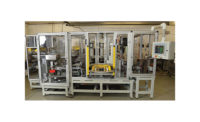For more than 30 years, Owens Design Inc., located in Silicon Valley, has specialized in designing and building advanced manufacturing systems.
When Owens Design was approached by one of the world’s largest technology OEMs to design an automated assembly line for a new, cutting-edge mobile device, the Owens engineering team faced several challenges.
First, they would have to accommodate the customer’s urgent time-to-market needs. Not only was it essential that the project be completed according to an aggressive schedule, but the customer would continue developing the device right up to the last minute, requiring rapid process changes to be constantly made as the assembly line was still being built.
As soon as manufacturing started, the OEM would need to quickly ramp-up to full, high-volume production, amounting to hundreds of thousands of units per week.
In addition, the device would require a large number of varied and complex process steps, including:
- Glue cleaning, edge taping and corona treatment of optical components.
- Precise parts alignment while applying pressure-sensitive, UV-cure and thermal-cure adhesives.
- Pre- and post-assembly vision inspection for quality control.
- Laser metrology.
- PCB insertion and alignment with optics.
- Electrical testing.
- Assembly and integration of three different subsystems into the product housing.
Finally, adhesive dispensing would have to be controlled in milligrams, and alignment tolerances for the device’s components would be on the micron level.
Taking all of this into consideration, Owens decided on a modular assembly line that would take advantage of the high degree of flexibility and repeatability offered by robots, along with a unique, high-precision parts presentation system specially designed by the Owens team.
“The finished line is 65 feet long and has 36 process stations,” says Fred Miller, an Owens Design senior engineer. “It uses 24 DENSO robots, both four- and six-axis models, plus 29 inspection and alignment cameras and 19 computers. Overall control of the entire system is provided by a Mitsubishi PLC.”
At the start of the line, robots pick parts presented by JEDEC trays and tape reels, and place them into custom-designed fixturing carriages attached to the first of three successive conveyor belts. The parts are then delivered in the carriages to each of the process stations, where other robots or dedicated automation carry out specific operations. The robots have a repeatability down to 25 microns, and the dedicated automation has a repeatability down to 10 microns.
Because of the close tolerances involved, the parts carriages play a critical role in the production process. The carriages have a bottom side tooling plate made of hardened stainless steel, enabling the high accuracy required to position the device’s NC-machined parts. The top surface of the carriages are made from polyether ether ketone (PEEK), a high performance, long-wearing polymer that prevents the parts from being scratched, while also providing static dissipation.
“When a part is placed into one of the pockets in the carriage,” says Miller, “spring-activated clamps hold it in place, and it is then very accurately located in three dimensions in space. This allows high-precision operations to be performed repeatedly on the part as it travels from station to station.”
At the end of the line the carriages flip underneath the conveyor and are brought back to the beginning in an endless loop, eliminating the need for a separate return conveyor.
“This was a complex and demanding project,” says Tony Smith, Owens Design engineering manager. “Along with the parts carriages, the robots we used were essential to our success.
“We chose DENSO robots because we knew they were reliable and robust, plus they had the repeatability we needed. Their small form factor made them easy to integrate into the system, and they were also easy to program and network. The DENSO engineers were very responsive, and gave us excellent support and training.”
For more information on assembly robots, call DENSO Robotics at 888-4-ROBOTX or visit www.densorobotics.com
Editor’s note: Whether you’re a systems integrator or the in-house automation team of an OEM, if you’ve designed a system that you’re particularly proud of, tell us about it. Send an e-mail to John Sprovieri, editor of ASSEMBLY, at sprovierij@bnpmedia.com, or call 630-694-4012.








